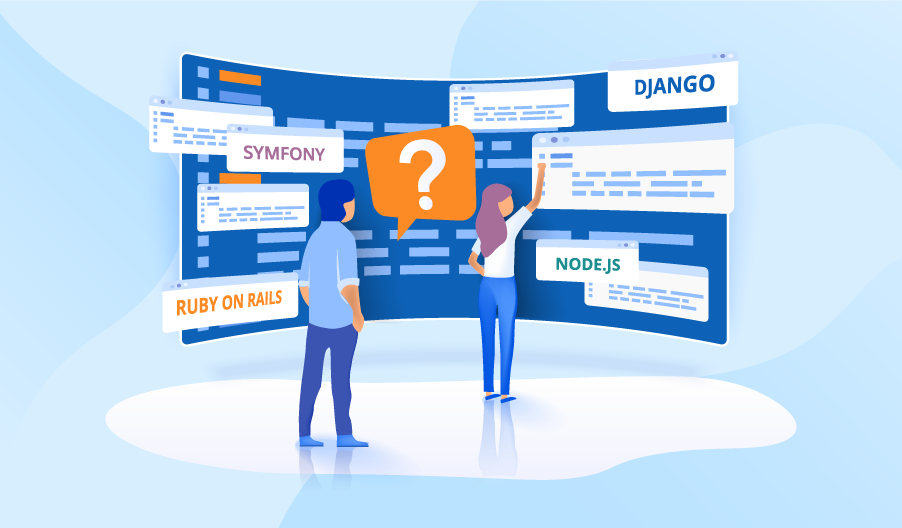Choosing the “Best Fit” Back-end Framework: the Dark Side of Web Application
Each web application is expected to have both the aesthetic look and the solid inside. If the back-end monster reveals itself to end users, they can be scared into not ever using the application again. Disappointing UX, a high application downtime, incompatibility issues, etc., often occur as a result of back-end development mistakes.

Picking a web development team, clients may imply working with the technologies with which they are familiar. However, it’s better to complete different tasks by leveraging most appropriate technologies, and it’s wiser to have some more grounds for the choice than a mere “I’m sure how it works.”
To build an edge, a skillful programmer always has a list of preferable frameworks. That is why a highly professional development team can offer clients best practices ensuring a cost-effective development process to meet the deadlines that always matter.
A framework is a value-adding element for both front-end and back-end development. The front end, the client side, is only the tip of the iceberg. The back end, the submerged part of this iceberg, is the compilation of tools, scripts, APIs, and external libraries. Only developers can see this dark side of a web app. This article provides a glimpse of some most popular frameworks tied to programming languages respectively.
Symfony – PHP
Probably the most popular server-side language, PHP was designed for web-based development, while many other programming languages were adapted for the web. More than 80% of all the websites in the world are PHP-based. PHP is agile, shows compatibility with excellent CMSs and can be hosted practically everywhere. It doesn’t require outstanding development skills to master.
A popular PHP ORM framework, namely Symfony, requires, however, solid development knowledge and experience. It is an open-source set of technologies that provides reusable libraries as the basis for crafting best PHP applications. All Symfony components can be used alone, but the whole framework equips developers with easy upgrades and maintenance options enabling a smooth app-building process. Also, Symfony technology has the company behind it, which provides official support, tutorials, and certificates. This framework will perfectly fit for building content-rich sites.
Node.js (Express/Meteor) – JavaScript
Node.js offers an environment that powers the development of full-stack JavaScript applications. Given the capabilities provided by JavaScript for both the front end and the back end, no wonder that Node.js frameworks enjoy overwhelming popularity.
One of the most popular Node.js open-source frameworks is Express. It is classic in terms of common web apps development. A server-side framework, Express can be employed by developers of different levels: it provides minimum features required to build HTTP server in Node.js. Express can be used as a middleware framework in the same way PayPal and MySpace do.
This framework is an excellent choice for apps requiring multiple online connections and quick data retrieval from a database. A trap here is the necessity to install additional libraries and other packages, and further, always state aware of compatibility issues. It doesn’t make real sense to use Express for complex web portals, while its use may be perfect for the development of simple web applications.
Another noteworthy Node.js framework is Meteor.js. This full-stack framework implements Model-View-Controller pattern (MVC). Meteor employed, JavaScript can serve as the client/server language. What is more, there are several dozens of additional packages that developers can use as supplements to this framework.
Meteor-based apps can be run on the devices that have such operating systems as OS X, Windows, and Linux. Another perk is the cloud deployment service, namely Galaxy, built specifically to run Meteor apps. To make this server work for your custom application, you will need to create an account and use a MongoDB database. Via Galaxy UI, developers can manage the number of views and resource usage, change settings to adjust Galaxy environment variables.
This framework is the right choice in case you are going to kick off a new web app development project to acquire a solution with real-time sync., reactive and gorgeous UI, and building target audience capacity.
Django – Python
It is an open-source full-stack framework for perfectionists stuck to strict deadlines. It supports Python up to 3.7 version, so developers can take advantage of the improvements provided in latest Python releases. Django supports different databases, thus automating and facilitating migration between two databases. Among them are MySQL, PostgreSQL, SQLite, Oracle, and others. Additionally, there are back ends provided by 3rd parties that allow using several other databases with this framework.
Django supports rapid development and pragmatic design, helps handle traffic and zillions of site views. It is employed in many high-loaded websites, e.g., Reddit Gifts and NASA, and can be used for startups and small-scale websites as well due to rich out-of-the-box functionalities it provides.
Ruby on Rails – Ruby
For startups or small development teams, Ruby on Rails – simply “Rails” – is the best choice to have a new web application up and running in the shortest time possible. This full-stack framework is open for contributing code to help make it even better. It is scalable and allows creating high-traffic websites in a time-consuming manner.
Rails provides the developers with fantastic tools to promptly build dynamic websites, facilitates creating and testing prototypes, and makes the whole development process cost-effective. The MVC pattern Rails is built on allows expanding complex apps, adding new custom features or app’s logic.
The framework has a RESTful API architecture, and this eliminates the necessity of hiring somebody to design the one. Developers often pick this framework for agile software development. So for example, Ruby on Rails is used by such websites as GitHub and Twitter.
In a nutshell
Whatever is the chosen framework, it should meet specific business needs, the project budget, and customer requirements on a would-be solution. Therefore, if you crave to meet or even surpass the expectations of the target audience, start with picking the “best fit” technologies prior to launching the development process. Regardless of the type of your business, a professional software development services provider can anytime assist you in the mission of building an efficient and user-friendly solution.

